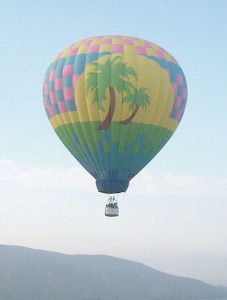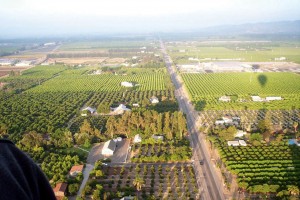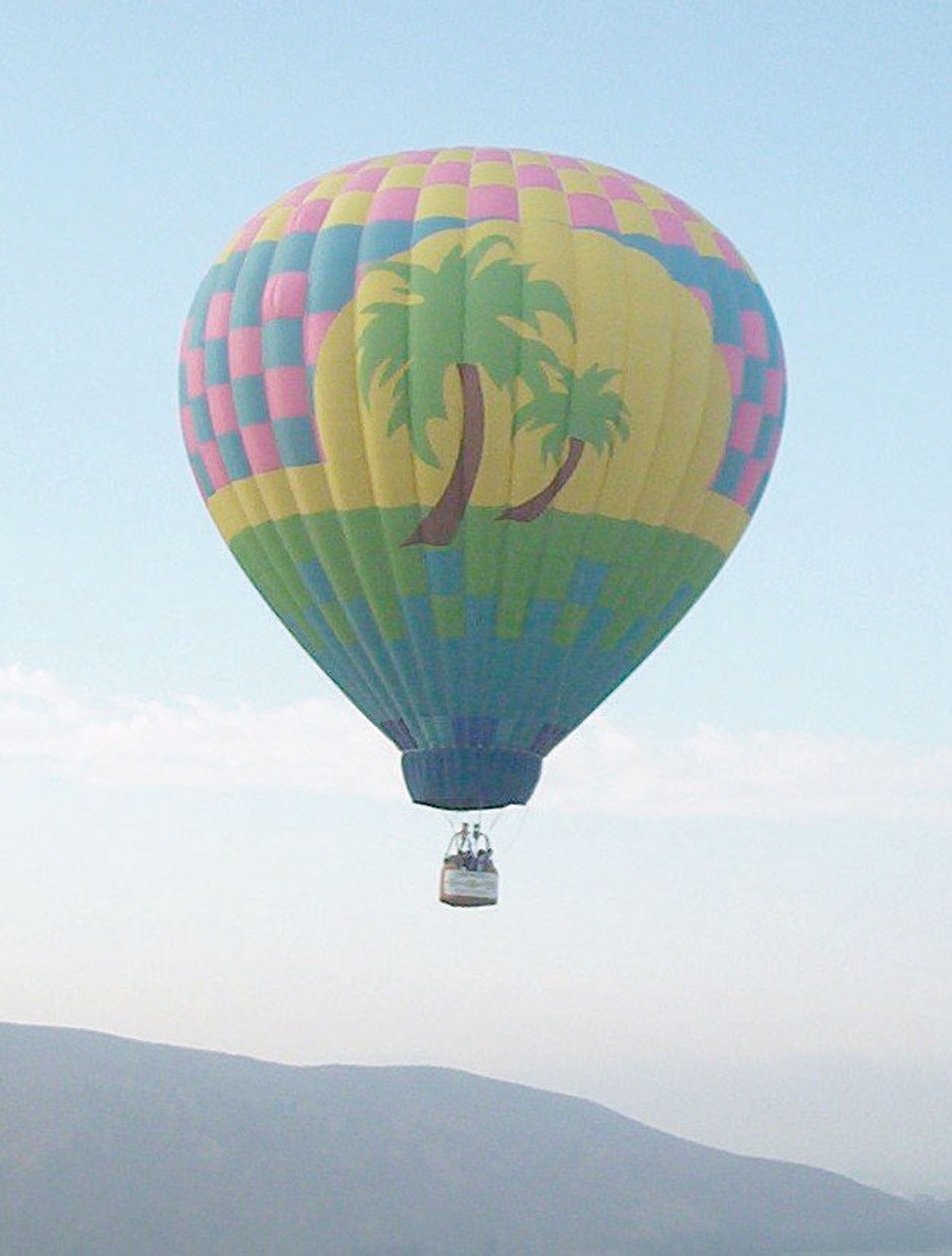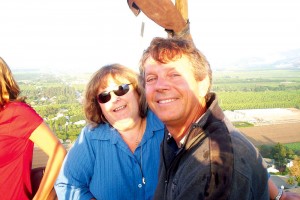
Each balloon was unbundled with the basket on its side. When inflated with hot air from the propane burners, the balloon rose and the basket tilted upright.
By Fred “Crash” Blechman
If you were driving on the Santa Paula Freeway at 7 a.m. on a recent Tuesday morning and saw two brightly colored hot air balloons floating nearby, I might have been in the basket below one of them—and loving it!
In my checkered flying career, I’ve flown as fast as 400 miles an hour in F4U Corsairs when I was a Navy fighter pilot, or as slow as 30 miles an hour guiding the Goodyear Blimp over Palos Verdes Estates. I’ve even hovered in helicopters. But I’d never had the fun of hanging in a strong wicker basket under a mass of 190 to 300 degree hot air in an eight-story high, 210,000-cubic-foot polyester Dacron bag, watching a quilt of farmland pass under me at the lazy pace of a walk. Such was the experience on my 80th birthday flight with Fantasy Balloon Flights, a few miles south of Santa Paula Airport (SZP) in Ventura County, 60 miles northwest of downtown Los Angeles.
I wasn’t exactly a pioneer doing this. A sheep, a duck and a rooster were the first passengers in a hot air balloon made of layers of paper and fabric, launched in 1783 by the Montgolfier brothers in Versailles, France. Not long after, the first human balloon passengers flew five miles in 25 minutes. Progress being what it is, we flew about three miles in an hour, since we were “gone with the wind.”
The only directional and speed control a balloon pilot has is seeking a different wind velocity and direction by changing altitude. Changing altitude is accomplished by varying the balloon internal temperature, and this is done by lighting—or not lighting—a propane burner aimed upward into the balloon. The blast sounds like a loud flamethrower.
Our pilot was Steve Wilkinson, an FAA certified commercial pilot/instructor, and one of the foremost hot air balloonists in the world, winner of many balloon-racing championships. He has flown hot air balloons over 2,000 hours in many different countries around the world, and formed Fantasy Balloon Flights with his wife, Cindy, in 1981.

Our 210,000-cubic-foot balloon, Circus Star, had a 42-million-BTU propane “flamethrower” to heat the air in the balloon to 300 degrees Fahrenheit.
I wasn’t alone with Steve on this balloon flight. My daughter, Sherry Williams, arranged my birthday flight, and with us in the basket (in addition to a bunch of propane cylinders) were Robert James Wagstaff (computer guru, owner of Complete Network Solutions), his mother, Jean, his two children, Ryan (10) and Ashley (14), and one of his employees, Matt Moran.
We met at 5:30 a.m. at Limoneira Tours, to be briefed and to sign the required release forms. Then we drove to the launching sight a couple of miles away. Two balloons were being inflated with hot air as we arrived, with the smaller 120,000-cubic-foot capacity balloon using a four-passenger-plus-pilot basket. Our balloon, the larger one, was called Circus Star and could carry eight passengers plus the pilot.
By 6:35 a.m. we had climbed (literally) into our basket and, with a blast from the “flamethrower,” Steve lifted us gently into the slight breeze. The other balloon (piloted by Steve’s son, Justin) had already started its ascent. The sun was just beginning to rise, with scattered high clouds and a blue sky, but the ground haze limited horizontal visibility to about five miles. With “a bird’s eye view” we could clearly see directly below as we rose to several hundred feet, with mountains to the east and west, but we couldn’t see the Pacific Coast or the Channel Islands.

An agricultural panorama of growing fruits, vegetables and flowers, and many farmhouses passed slowly beneath us as the wind carried us toward the town of Saticoy.
As the neatly manicured and colorful agricultural basket of orange, lemon and avocado fields—mixed between patches of strawberries, celery, cilantro, cabbage, and other crops—passed below us and became smaller, so did the roads, cars and farm houses. People were leaving for work as we floated nearby, and we watched the tiny cars on the Santa Paula Freeway and other roads.
Wind turbines, intended to provide farm electricity, dotted the landscape, but there wasn’t enough wind to turn the propellers. We felt no breeze at all, since we were traveling with the wind. The other balloon was nearby, sometimes higher and sometimes lower than we were. As we watched them, it was hard to tell whether we were going up, or they were going down, or just the opposite.
Periodically, when Steve wanted us to go higher, or to stop a descent, he turned on the noisy propane burner for about 15 seconds. (The burner also produced a lot of heat, so wear a hat if you will be anywhere near it.) Steve had a device that showed the altimeter and temperature at the top of the balloon, to make sure it didn’t exceed 300 degrees Fahrenheit, which could damage the balloon fabric. Our altitude during the flight ranged from 100 feet above the ground (where we shouted down to some workers picking cabbage, and they responded) to about 900 feet.
As an hour aloft approached, a large empty field below became our landing target. The other balloon landed first. As we descended, we were heading directly for a large wind turbine tower and propeller, but Steve operated a side vent just enough to miss the turbine. We landed smoothly. Chase crews had followed us in two 4X4 vans, and had been in radio contact with the balloon pilots to provide support on the ground after landing. They unfolded large tarpaulins, pulled on some ropes to collapse each balloon, and neatly folded them into the tarps in amazingly small bundles that were loaded into the back of each van.
As the balloons were being bundled, we followed a 200-year-old tradition with iced champagne served in fancy Fantasy Flight etched goblets (available as mementos for $7 each). Orange juice, sparkling cider and cookies were also served as Steve commemorated the adventure by reciting the “Balloonist’s Poem” and presented us each as new “aeronauts” with an individual signed “certificate of ascension.”
The fare for the balloon adventure is $170 per guest inclusive, with discounts given to groups, families, children and seniors. Private charters for two or more are available, as are corporate group functions. One-week advance notice is usually plenty of time to secure your desired flight date. Wedding Aloft is one of their specialties, and tether promotions are available at your business or other site. A Fantasy Gift Passport is the perfect surprise for any occasion.
Fantasy Balloon Flights operates from different locations during the year, depending on weather patterns. Flights are typically offered from Santa Paula from May to October, and from the Palm Desert area November to April.
For more information or to make reservations, call 1-800-GOABOVE or visit [http://www.fantasyballoonflights.com]. Fred “Crash” Blechman’s two flying books, “Bent Wings – F4U Corsair Action & Accidents: True Tales of Trial & Terror!” and “Flying with the Fred Baron,” are available at [http://www.amazon.com]. You may contact him by e-mail at crash@airportjournals.com.













